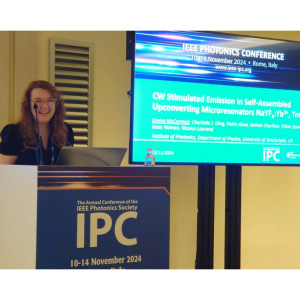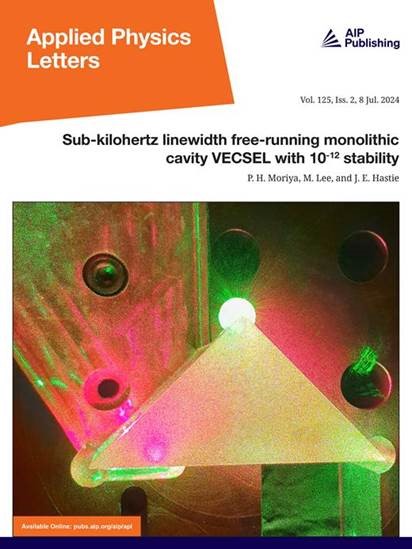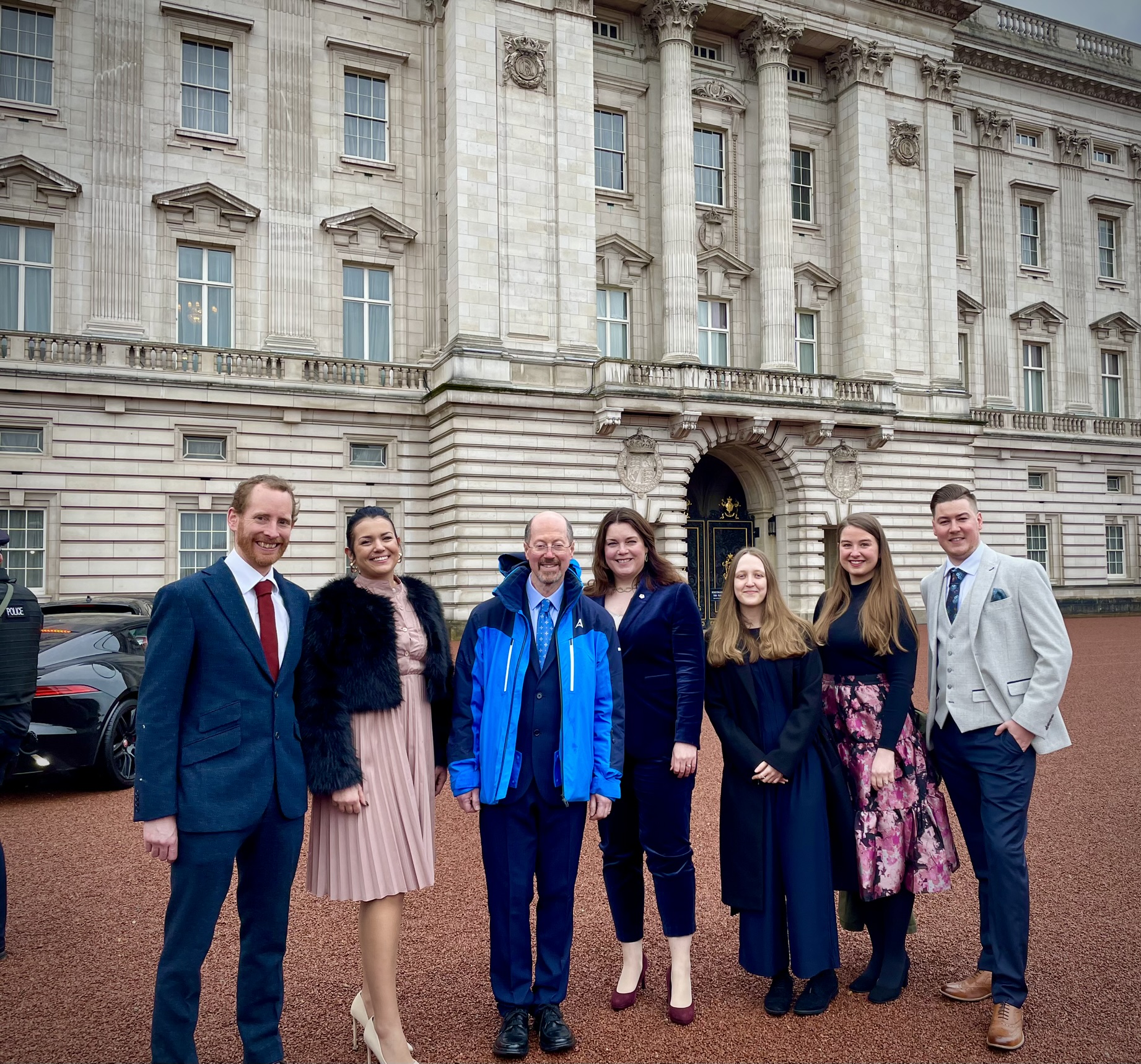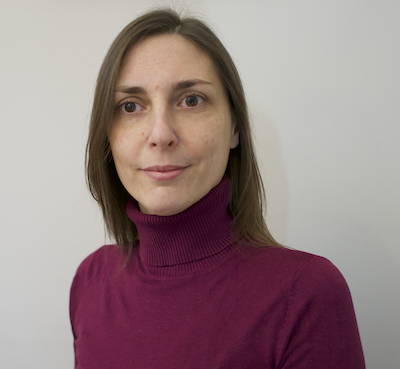Other news articles
Long-serving IoP staff member recognised by prestigious Strathclyde Medal
Dr Ian Watson, one of the originally appointed Research Team Leaders in the Institute, who joined in 1998, has been recognised for his distinguished and exemplary service to the University of Strathclyde over the past 25 years. In a dedicated ceremony on 17th November, hosted by the University’s Principal and Vice-Chancellor, Professor Sir Jim McDonald, Ian was one of only 16 staff from across the University to have his contributions recognised by award of an Individual Strathclyde Medal.
Ian has been a remarkable colleague to all those who have been privileged to work with him. He has unique expertise in compound semiconductors and all aspects of microfabrication and he has underpinned the Institute’s broad range of work across all areas of optoelectronic materials and devices. His thoroughness and dedication in all aspects of his work, and his loyalty to and support of his colleagues, have been evident throughout all his time at Strathclyde.
Many congratulations, Ian!
Strathclyde awarded Queen's Anniversary Prize for photonics innovation
Announced at a reception in St James’ Palace, the award celebrates our internationally recognised photonics ecosystem which has been developed over more than three decades.
Strathclyde wins Queen’s Anniversary Prize for photonics innovation | University of Strathclyde
Professor Jennifer Hastie elected Optica Fellow
Institute of Photonics Director Professor Jennifer Hastie has just been elected Optica Fellow “For leadership in the photonics and quantum technology community and pioneering technical contributions in the area of narrow-linewidth lasers.”
Jonathan McKendry and Dr. Graeme Johnstone appear in a short YouTube video produced by The UK Quantum Technology Hub in Quantum Enhanced Imaging (QuantIC).
The video, which can be viewed here, showcases our flagship Micro LED array called “MegaProjector”, which is capable displaying more than half a million frames per second and can be used for a variety of applications including Single Pixel Imaging, Optical Communication and Fluorescence Lifetime Imaging.
QuantIC brings together industry and academia in a collaborative project to revolutionise imaging across industrial, scientific and consumer markets, with the Institute of Photonics being one of eight academic partner institutions.
https://www.youtube.com/watch?v=v5zPLBm57fA
Charlotte Eling awarded IPC Travel Grant
Charlotte Eling was awarded an IEEE Women in Photonics travel grant for this years' IEEE Photonics Conference (IPC) taking place from 12-16 November 2023 in Orlando, Florida.
The travel grant was awarded by the IEEE photonics society to women within the field that have contributed to outreach aimed at encouraging more young women to pursue a career in photonics. The travel grant encourages young professionals from a minority background to take part in the conference.
IoP researcher wins award at ESLW 2023
The 2023 European Semiconductor Laser Workshop (ESLW), hosted by the University of Glasgow, this year awarded the best oral presentation to Dr. Joshua Robertson, a member of the Institute's Neuromorphic and Nanophotonics group. Dr. Robertson presented his research of the development of photonic Spiking Neural Networks with Vertical Cavity Surface Emitting Lasers for the fast and efficient processing of classification tasks.
£4.7M consortium to accelerate growth of Scotland’s photonics sector
The Universities of Strathclyde and Glasgow are leading a new consortium which has won £4.7M in funding to support the tripling of the photonics sector across Scotland’s central belt. The Engineering and Physical Sciences Research Council (EPSRC), part of UKRI, announced that the consortium is one of 10 established industrial clusters across the UK which have received funding from the Place Based Impact Acceleration Accounts.
Professor Jennifer Hastie, Director of Strathclyde’s Institute of Photonics, and the consortium’s deputy principal investigator, said: “We have fantastic photonics capability in the central belt of Scotland, at universities and in industry, and an innovative, world-leading research cohort, yet in many ways it’s a ‘hidden economy’ of which we want to increase awareness, particularly among the next generation, and this new consortium will be ideally placed to achieve this."
IEEE Photonics Conference 2023
The IoP’s staff and students will present 8 papers at November’s IEEE Photonics Conference in Orlando, Florida, representing one of the largest overall contributions to the conference from any single research institute worldwide. This includes two invited papers, one by Dr Javier Porte Parera on ‘3D photonic interconnects for scalable neural networks’ and one by Michael Strain and Martin Dawson on ‘Transfer Printing Integration for Chip-Scale Photonic Devices’. The contributed talks are ‘High speed single pixel imaging with advanced microLED digital light projector’ given by Graeme Johnstone, ‘Micro-LED nanosecond pulsed structured light sources with 405nm – 510nm wavelength’ by Johnathan Gray, ‘Gigabit per second UV-C LEDs for communications’ by Hichem Zimi, ‘Photonic VCSEL-based RC for classification of RADAR signals’ by Joshua Robertson, ‘Enhancing the luminescence efficiency of colloidal quantum dots in compound supraparticles’ by Pedro Alves, and ‘Photocatalytic-ready supraparticle lasers’ by Charlotte Eling. Dr Nicolas Laurand will also attend the conference in his role as a member of the IEEE Photonics Society’s Conference Council.
Professor Martin Dawson receives the Sir Harold Hartley Award from the Institute of Measurement and Control
The IoP’s Director of Research, Professor Martin Dawson FRS, has been announced as this year’s recipient of the Sir Harold Hartley Award from InstMC. This prestigious Award recognises ‘Outstanding contribution to the technology of measurement and control’ and is awarded to Martin for his career-long contributions to the development and application of laser and semiconductor based optical devices and for his scientific leadership of the Fraunhofer Centre for Applied Photonics. The Award will be presented on 26th October in a ceremony at Prince Philip House, the headquarters of the Royal Academy of Engineering, during which Prof. Dawson will give a guest lecture.
Researchers develop approach that can enable inexpensive mass manufacturing of micro-LED displays
Researchers have demonstrated a continuous roller printing process that can pick up and transfer over 75,000 micrometer-scale semiconductor devices in a single roll with very high accuracy. The new method paves the way to creating large-scale arrays of optical components and could be used to rapidly manufacture micro-LED displays.
The Institute of Photonics is partner in an ambitious project to develop an optical communications system with a very low size, weight, and power (SWaP) footprint, optimised for use on high-altitude pseudo-satellites (HAPS) and other SWaP-limited platforms.
HAPS platforms are light-weight, unmanned aerial vehicles offering prolonged flight at altitudes into the stratosphere. They can be rapidly deployed and provide persistent coverage over large areas. HAPS platforms find applications in disaster relief, remote sensing and monitoring, and the provision of telecommunications to remote areas. With increasing congestion of the radio frequency spectrum, ever higher bandwidth requirements, and tight SWaP constraints optical communications are key to enabling such applications.
The project – Micro-LED HAPS – is led by Fraunhofer UK with project partners TAO Tech UK Ltd, A2E Ltd, Wideblue Ltd, Kubos Semiconductors Ltd, and the University of Strathclyde. The collaborative project is co-funded by the UK’s innovation agency, Innovate UK.
Micro-LED HAPS will harness advances in micro-LED light sources and single-photon detectors to create an ultra-compact optical comms system, for links between HAPS and other platforms/ground stations. The project builds upon two decades of pioneering research at the University of Strathclyde’s Institute of Photonics in the design, fabrication, and applications of micro-LEDs.
A press release can be found at https://optics.org/press/5687
Professor Martin Dawson FRS presented the 45th Edwards Lecture at City University on 15 February 2023
Professor Martin Dawson FRS presented the 45th Edwards Lecture at City University on 15th Feb. Professor Sir Anthony Finkelstein, President of City, said “The [Edwards] lecture has a distinguished history, having been given over the years by five Nobel Laureates, as well as many Fellows of the Royal Society and Fellows of the [Royal] Academy of Engineering”.
Prof. Dawson’s lecture was on laser research and innovation at the Fraunhofer Centre for Applied Photonics and this year’s event marked the 50th anniversary of the lecture given by Nobel Laureate and inventor of holography Professor Dennis Gabor.
https://www.city.ac.uk/news-and-events/news/2023/02/45th-edwards-lecture
IoP Student wins first-ever Falling Walls Foundation Scotland Competition
Matěj Hedja, PhD student at Institute of Photonics, won the Scottish Falling Walls Lab competition, which was arranged by Glasgow Innovation District and INSPIRE and was held in the Technology and Innovation Centre. Matěj then travelled to Berlin to deliver his pitch "Breaking the Wall of Efficient AI Computing Using Light" at the Falling Walls Science Summit along with other 80 other National winners. Unfortunately he was not among the 3 Global winners but it was a fantastic experience and he done himself and his colleagues extremely proud.
A programmable optical device for high-speed beam steering has been developed in research involving the University of Strathclyde.
The paper is a collaboration led at MIT and also involving Flexcompute Inc., the State University of New York Polytechnic Institute, Applied Nanotools Inc., the Rochester Institute of Technology and the U.S. Air Force Research Laboratory. It has been published in the journal Nature Photonics.
New device can control light at unprecedented speeds | University of Strathclyde
A full degree-of-freedom spatiotemporal light modulator
Best Paper Award from IEEE Photonics Technology Letters
A paper based on the research produced by Strathclyde's Institute of Photonics and LiFi R&D Centre has received the 2022 Best Paper Award from IEEE Photonics Technology Letters.
Collaboration in Science and Engineering wins research journal award | University of Strathclyde
Institute has paper published in Nature Communications
Institute of Photonics has a paper published in Nature Communications with research group from Stanford University.
Professor Martin Dawson, Director of Research, has been elected a Fellow of the Royal Society
This highly prestigious honour is in recognition of Martin’s research career and international leadership in the fields of optoelectronics and laser technology. https://royalsociety.org/news/2022/05/new-fellows-2022/
Institute's Professor Martin Dawson wins second International Award in one year
Professor Martin Dawson, Director of Research has been named as the 2021 winner of the Global SSL Award of Outstanding Achievement by the International SSL (solid state lighting) Alliance (ISA).
The award is presented to individuals or organisations “who stay at the forefront of SSL development, whose outstanding contributions have changed our lives, and who lead the field with innovative applications impacting human society.”
High-accuracy integration of photonic devices from multiple-materials in close proximity offers unique possibilities of fabricating chip-based systems of more compact designs using optical devices.
A collaboration project between the University of Strathclyde, the University of Glasgow and the Australian National University, led by Michael Strain (Institute of Photonics, the University of Strathclyde) developed an enabling method to position devices of multiple materials in close proximity on host surfaces and systems, published in the Special Issue on Hybrid Integrated Photonic Platforms in Optical Materials Express.
The reported method, based on the concepts of reversible adhesion, allows the pick-and-place integration of micron scale devices with high densities and without disturbing already integrated devices. This provides unique opportunities for creating systems with reduced separations on single chip. The technology is not limited to optical devices and can be useful for electronics specialists. Their work was also highlighted by Optica (former OSA) in a news release (https://www.optica.org//en-us/about/newsroom/news_releases/2021/researchers_integrate_optical_devices_made_of_mult/)
EPSRC highlights IoP research on advanced laser technologies for quantum technology
In a case study published this week the Engineering and Physical Sciences Research Council has highlighted the IoP’s work on the development of semiconductor lasers for optical engineering and quantum technologies.
https://epsrc.ukri.org/newsevents/casestudies/advancing-laser-technologies/
Institute Director of Research, Professor Martin Dawson receives the IEEE Photonics Society Distinguished Service Award
This award is a second success for the Institute this year, following on from Martin’s earlier OSA Nick Holonyak Jr Award https://www.osa.org/en-us/2021holonyakawardwinner/
https://www.photonicssociety.org/awards/distinguished-service-award
Institute has 2 chapters published in Micro LEDs book published by Academic Press
A new book on “Micro LEDs”, Vol. 106 in the series ‘Semiconductors and Semimetals’, has been published by Academic Press, which contains two chapters by Institute of Photonics authors - one on biomedical applications of the technology and one on optical wireless communications applications”.
Optical Society of America highlights IoP work on photometric stereo imaging
In a press release today (11th January), the Optical Society of America has highlighted the IoP’s work on photometric stereo imaging as published in a paper in the journal Optics Express. The paper, by IoP PhD student Emma Le Francis as lead author and entitled Synchronization-free top-down illumination photometric stereo imaging using light-emitting diodes and a mobile device, Opt. Express, 29, 2, 1502-1515 (2021) , describes a novel approach to synchronising LEDs and camera in photometric stereo imaging and introduces a top-down illumination geometry appropriate for applications linked to indoor lighting. The link to the press release is accessible here: Researchers Acquire 3D Images with LED Room Lighting and a Smartphone | News Releases | The Optical Society (osa.org)
Turing AI Acceleration Fellowship awarded to Institute of Photonics Dr Antonio Hurtado
Dr Antonio Hurtado, Senior Lecturer, at Institute of Photonics has received a prestigious fellowship to support his development of ultra-fast Artificial Intelligence (AI) technologies for medicine, security and renewable energy
Martin Dawson gave (remotely) a keynote and an invited talk at conferences in China last week and will give a further invited talk at a conference in Japan in December
The keynote talk, entitled ‘Micro-LED cutting edge technology and innovative applications in the field of displays, wireless optical communication and imaging technology’ was given to an audience of several hundred in the Plenary Session of the prestigious 17th China International Forum on Solid State Lighting (SSL China) & 2020 International Forum on Wide Bandgap Semiconductors (IFWS) , Nov 23-25 2020, Shenzhen, Guangdong, China http://www.sslchina.org/summit?lang=en&id=16
The invited talks were/are in the Micro-LED forum at the 2020 World Display Industry Conference (2020 WDIC) at Hefei, China, Nov 20-21 2020 and at the upcoming 27th International Display Workshops (IDW’20), Dec 9-11, Fukuoka, Japan. These conferences are associated with or organised under the auspices of SID, the Society for Information Display.
Institute is Strathclyde's lead on £10 million Quantum Technology project
Dr Michael Strain of the Institute of Photonics, in the University of Strathclyde's Institute of Photonics, will, alongside Professor Martin Dawson, lead the Strathclyde contribution to this programme. The project is funded by the UK Quantum Technologies Challenge led by UK Research and Innovation and will look at increasing the reliability - and reducing the size, weight, power consumption and cost - of laser components and systems.Dr Michael Strain of the Institute of Photonics, in the University of Strathclyde's Institute of Photonics, will, alongside Professor Martin Dawson, lead the Strathclyde contribution to this programme. The project is funded by the UK Quantum Technologies Challenge led by UK Research and Innovation and will look at increasing the reliability - and reducing the size, weight, power consumption and cost - of laser components and systems.
Royal Academy of Engineering award for Institute Deputy Director, Dr Michael Strain
Dr Michael Strain, Deputy Director of Institute of Photonics has been awarded a Senior Research Fellowship by the Royal Academy of Engineering. Dr Strain’s research will be aimed at the miniaturisation of visible light optical systems onto a single chip. By integrating systems onto a chip, complexity can be significantly scaled up while improving mechanical robustness, power consumption and reducing production costs.
The long-term aim of the work is to take make optical systems in a format which can be integrated with portable, low power electronics, such as chip-scale spectrometers integrated onto mobile phone platforms for point-of-use diagnostic tools.
Tiny devices promise new horizon for medical imaging
Miniature devices that could be developed into safe, high-resolution imaging technology, with uses such as helping doctors identify potentially deadly cancers and treat them early, have been created in research involving the Institute of Photonics.
IoP recent work on Micro-LED based visible light communication reported by IEEE Spectrum
Based on our self-developed micro-LED array following in-series configuration, high-speed visible light communication links have been achieved at different free-space distances [1]. Over 10 Gbps data rates are accomplished within 5 m transmission distances. Extending the transmission distances to 20 m, the data rates are maintained at the Gbps. This work was also reported in IEEE Spectrum on 15 April which can be read here.[1] E. Xie et al., "Over 10 Gbps VLC for Long-Distance Applications Using a GaN-Based Series-Biased Micro-LED Array," in IEEE Photonics Technology Letters, vol. 32, no. 9, pp. 499-502, 1 May1, 2020
https://spectrum.ieee.org/tech-talk/telecom/wireless/micro-led-lights-transmit-whopping-amounts-data
Single photon sensitive link across Glasgow city centre
In collaboration with Edinburgh University and Clyde Space AAC, researchers at the Institute of Photonics are developing optical communications systems with extremely small size, weight and power requirements operating with single photon sensitivity. These systems, developed as part of the “QuantIC” National Quantum Hub, are attractive for data transmission between cube satellites. In December 2019, an important breakthrough was achieved, when we experimentally demonstrated a long distance link over 750 m. Watch live footage from the day, as we used microscopic light-emitting diodes and single photon detectors to beam data at 20 Mb/s across Glasgow city centre.
https://www.youtube.com/watch?v=5aorYup1BMg
Led-by-LED technology demonstrators
In November 2019 researchers from the Institute of Photonics showcased technology demonstrators at the National Quantum Technologies Showcase at the Queen Elizabeth II Exhibition Centre, and at the “Quantum City at the Royal Institution”, both in London. The exhibit at the Royal Institution has been filmed. Please watch Dr Herrnsdorf explain the research on micro-LEDs and single photon detectors that is happening at the Institute of Photonics as part of the “QuantIC” Quantum Hub.
https://www.youtube.com/watch?v=FothKdobNck
Two ‘Best Paper’ Recognitions for the Institute of Photonics at the IEEE Photonics Conference 2019
At the IEEE Photonics Conference in San Antonio, Texas, last week, the IoP received two significant marks of recognition for its work on micro-LEDs and visible light communications:
The first was the IEEE Photonics Technology Letters Best Paper Award 2019. This award is given 3 years’ retrospectively for the Best Paper published, in this case in 2016, as Reviewed by the PTL selection committee based on four criteria; Originality, Technical Content, Impact, and Presentation. The paper, entitled “High bandwidth GaN-based micro-LEDs for multi-Gb/s visible light communications” by R.X.G. Ferreira et al., is a collaboration between the IoP and teams from Oxford, Cambridge and Glasgow Universities, supported under the EPSRC UP-VLC Programme Grant (2012 – 2017) that was led by Strathclyde. It was selected out of over 600 papers published by the journal in 2016 and currently tops the Popular Articles list of IEEE PTL, with over 9,469 full text views.
The second was the 2nd place award in the Student Best Paper award competition, recognition given to IoP/Fraunhofer PhD student Georgios Arvanitakis and his co-first-author IoP PhD student Jose Carreira for their paper entitled “Underwater wireless optical communications at 100MB/s using integrated dual-color micro-LEDs”. Georgios and Jose will share the $500 prize money awarded.
Well done to all concerned!
Neurophotonics team publish new article in Optics.org
In a recent news article, Optics.org have featured ground breaking work by the Neurophotonics team at the Institute of Photonics. They discuss a new LED optical array that is capable of independently illuminating specific brain regions, while also providing wide-area brain surface illumination. And if operated correctly, everything stays cool.
https://optics.org/news/10/9/26
Photonics Research Journal
A paper based on research from the Photonics Materials and Devices group, titled “1 Gbps free-space deep-ultraviolet communications based on III-nitride micro-LEDs emitting at 262 nm”, has been selected for the front cover of the Photonics Research Journal’s special issue on Semiconductor UV Photonics.
https://www.osapublishing.org/prj/home.cfm
Congratulations to our Director, Professor Keith Mathieson, who has been awarded a prestigious Chair in Emerging Technologies by the Royal Academy of Engineering (RAEng)
Professor Keith Mathieson’s appointment will enhance his research into technologies interfacing with the brain that aim to advance treatments for brain disorders, dementia and sight loss and will use the funding to explore neurotechnologies to treat these conditions. His aims will include systems for restoring functional vision to blind people, to be developed in partnership with Stanford University. He will also establish a centre for excellence in neurotechnologies at the University.
Professor Mathieson’s appointment, which he took up on 1 April 2019, will be worth just over £2.6 million in funding over its 10-year term.
SPACOMM 2019: Best Paper Award
Research presented by Dr Alex Griffiths at The Eleventh International Conference on Advances in Satellite and Space Communications (SPACOMM2019) has been selected as "Best Paper" for the conference. The presented work described how micro-LED technology can be used for low size, weight and power inter-satellite communications.
Strathclyde Chancellor's Fellow
Congratulations to Dr Johannes Herrnsdorf who has been successful in securing a Strathclyde Chancellor's Fellowship, which commenced in June 2019, as part of the Global Talent Programme 2019. Johannes' research focuses on high-speed electronic interfaces for optoelectronic devices.
Professor Martin Dawson invited speaker at ICDT Conference in China
The Institute of Photonics’ pioneering work over the past 20 years on micro-LEDs, an area now receiving great commercial attention as a new form of high-brightness and high resolution display technology, was showcased in the Plenary session of the International Conference on Display Technology (ICDT) in Kunshan, China (March 2019). This meeting, organised under the auspices of the Society for Information Display (SID), takes place annually in China, linked to China’s $30 billion (2018) display industry. Prof. Martin Dawson gave this well-received talk to over a thousand delegates from across all areas of the international displays research and commercialisation community.
Dr Antonio Hurtado is Strathclyde's lead on £3.354 million international project
An international project aimed at increasing the efficiency and portability of artificial intelligence (AI) technology has been launched with the University of Strathclyde as a partner.
The ChipAI Project is developing a nanoscale photonics-enabled technology capable of delivering compact, high-bandwidth and energy efficient neuromorphic (brain-like) central processing units (CPUs).
£80 million funding boost will help Scottish universities and businesses develop ‘quantum’ technology that could help save lives
Scottish universities are set to receive a share of an £80 million investment in quantum technology research that could save lives, the Chancellor of the Exchequer announced today on a visit to the University of Strathclyde.
The funding will be given over five years to four UK development centres - Glasgow, Birmingham, Oxford and York (with the Institute of Photonics being an academic partner of 3 of the Quantum Hubs) – to create technology that could help save more lives in search-and-rescue missions, hostage situations and help firefighters tackling a blaze.
Professor Allister Ferguson named Robert E. Hopkins Leadership Award recipient
Congratulations to Professor Allister Ferguson, founder of the Institute of Photonics, who has been named the 2019 Robert E. Hopkins Leadership Award recipient by The Optical Society.
Strathclyde Partners in Manufacturing Innovation Project
The University of Strathclyde has been announced as a partner in an ambitious, £5.54 million manufacturing research programme supported by the Engineering and Physical Sciences Research Council (EPSRC).
The five-year programme, named Hetero-print, aims to develop new techniques for creating advanced optical and electronic materials and devices by specialised forms of printing on the micro- and nano-scales.
Strathclyde partners in manufacturing innovation project
EPSRC UKRI Innovation Fellowship
Johannes Herrnsdorf won an EPSRC UKRI Innovation Fellowship on structured illumination and digital lighting at the few-photon level. Dr. Herrnsdorf will develop platform capability comprising microscopic light-emitting diodes and single photon detectors, which enable imaging and optical wireless networking using only a small number of signal photons.
The technology promises to have a small footprint, low power requirements, and high reliability. It may find application in space communications, the industrial internet of things, underwater communications, high-speed and low light level imaging, automated video surveillance, and micro-fabrication.
The Fellowship is hosted by the Institute of Photonics and strongly supported by Fraunhofer UK, the Scottish Centre of Excellence in Satellite Applications, the Advanced Forming Research Centre, and Aralia Systems.





